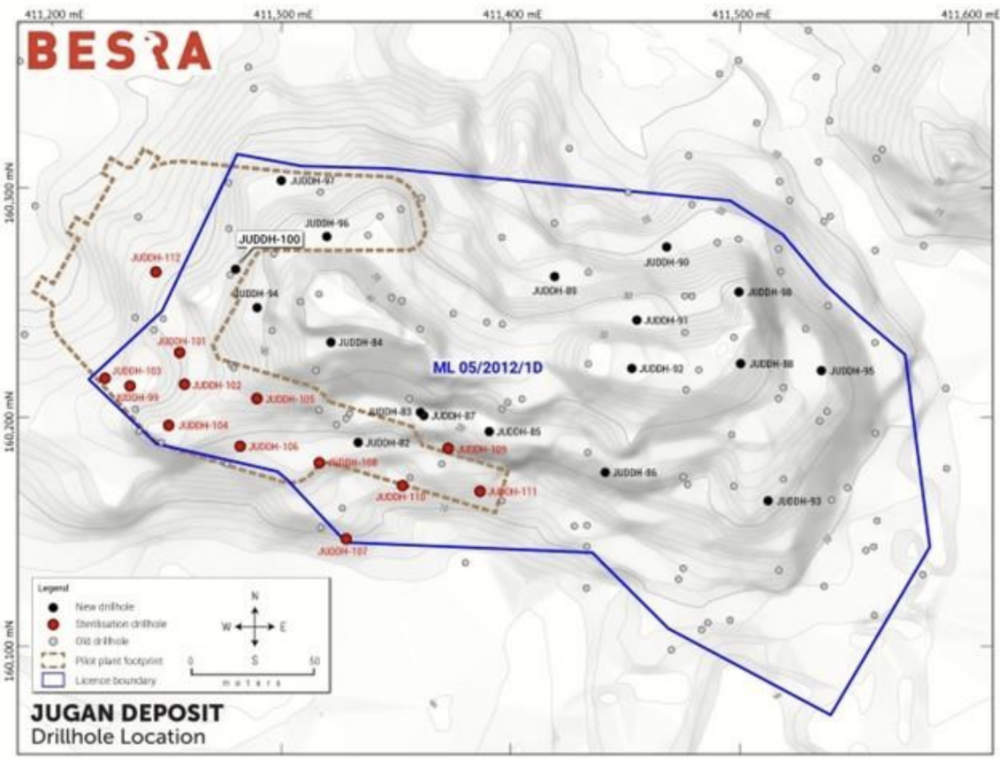Besra Gold infill drilling dials in higher than average gold grades

Besra calls with infill drilling that continues to hit higher grade mineralisation. Pic: Getty Images
- Besra Gold’s infill drilling at the Jugan prospect has intersected a 7m at 6g/t gold interval that betters the average gold grade
- Sterilisation drilling has struck gold below the previously interpreted base of Jugan mineralisation
- Further drilling will focus on the least well-defined portion of the potential open caste portion of the deposit
Special Report: Besra Gold’s infill drilling at the Jugan project as part of its definitive feasibility study on the 960,000oz deposit in East Malaysia continues to increase certainty in its resource as it returns assays that are higher than the average gold grade.
A notable example is hole JUDDH-100, which returned more than 60m of mineralisation including 7m at 6g/t gold from 90m and 13m at 2.6g/t gold from 146m.
This is hugely encouraging for Besra Gold (ASX:BEZ) as JUDDH-100 is the first in a further round of fully cored drill holes designed to refine resource estimations at Jugan, part of the broader 3Moz Bau goldfield controlled by Besra,
Notably, the infill program targets poorer controlled portions of the mineralisation’s geometry, making an increase and upgrade of the current resource likely.
The broader Bau gold project currently has a high confidence measured resource of 3.4Mt at 1.5g/t gold, or 166,900oz of contained gold, an indicated resource of 16.4Mt at 1.57g/t gold, or 824,800oz contained gold, and an inferred resource of 47.9Mt at 1.29g/t gold, or ~1.99oz contained gold.
The infill drilling will initially try to intercept the steeply plunging north-east limb of the Jugan mineralisation.
Results from this program will form a vital component of the definitive feasibility study being prepared as part of BEZ’s assessment for future commercial development at Jugan.
The company adds that the 7m at 6g/t gold interval at JUDDH-100 is exceptional relative to Jugan’s nominal global grades and that studies are underway to understand the likely controls for this occurrence in order to predict whether there may be other portions of Jugan mineralisation sharing similar attributes.

Mineralisation below pilot plant
Meanwhile, sterilisation drilling carried out to quantify mineralisation potential beneath the proposed Jugan pilot plant footprint has consistently met and in some cases bettered pre-drill expectations.
The company noted that this program encountered mineralisation below the footwall thrust, which has traditionally been interpreted as the base of Jugan mineralisation.
Notable intersections are:
- 8m at 2.6g/t gold from 23m (JUDDH-101)
- 24m at 3.2g/t gold from surface and 9m at 1.5g/t gold from 37m (JUDDH-105); and
- 18m at 1.85g/t gold from 4m and 9m at 1.5g/t gold from 37m (JUDDH-109).
BEZ noted that while the pilot plant is not intended to be a long-term permanent structure, it is important to assess during the DFS phase the extent, if any, of mineralisation lying beneath its footprint for the purposes of future commercialisation.
It added that JUDDH-105’s intersection of mineralisation about 12m below the footwall thrust replicates other reported occurrences of gold mineralisation in this area and warrants further review and possible changes to the mineralisation model locally as well as further consideration of the implications more generally.
Jugan pilot
BEZ is currently constructing the Jugan pilot plant, which is crucial to the development of the ~960,000oz resource, which is in turn part of the Bau project.
The 50 tonne per day plant will trial various batch processing combinations in order to develop optimal protocols for processing the Jugan refractory ore to produce a concentrate for further processing, including doré.
As such, these trial results will form an important component of the overall definitive feasibility study for future commercialisation.
The plant also has the required licensing and capability to increase the processing throughput to up to 200tpd.
Equipment for the pilot plant is already enroute from Yantai Jinpeng Mining Machinery and is due to arrive at Kuching Port in Sarawak on July 26, 2024.
Drilling carried out in 2021-2022 confirmed the standalone development potential of Jugan – including higher grades – with mineralisation starting from surface meaning that any mine will benefit from a low strip ratio.
Bau project
Jugan is part of the broader 98.5% held Bau project that sits 30-40km from Kuching, the capital of Sarawak state in Malaysia.
Bau is defined by a gold bearing mineralisation system covering an 8km by 15km corridor.
Besides its current resource across a number of deposits, it also has potential for further growth by directing drilling towards the exploration target of between 4.9Moz and 9.3Moz gold.
Next steps
Following the completion of the sterilisation program, BEZ plan for future drilling is to refocus on infill drilling.
It has negotiated private access arrangements with the occupiers of Lot 300, which adjoins ML 05/2012/1D, allowing it to drill several deeper drill holes to access the northeast plunging portion of the Jugan mineralised body where current drillhole control is relatively sparse.
The company plans to drill a number of directional, inclined, diamond core holes from pads within Lot 300 towards the south-west, which is predicted to provide the optimal intercepts of what is currently the least well-defined portion of the potential open cut portion of the Jugan deposit.
This article was developed in collaboration with Besra Gold, a Stockhead advertiser at the time of publishing.
This article does not constitute financial product advice. You should consider obtaining independent advice before making any financial decisions.
Related Topics

UNLOCK INSIGHTS
Discover the untold stories of emerging ASX stocks.
Daily news and expert analysis, it's free to subscribe.
By proceeding, you confirm you understand that we handle personal information in accordance with our Privacy Policy.








